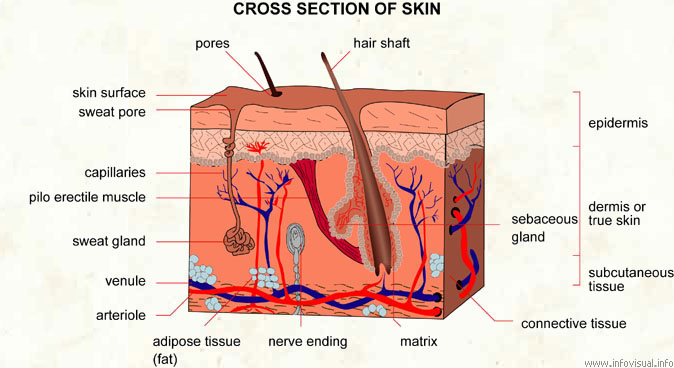
Transdermal Drug Delivery
PTA 101 Intro to Clinical Practice 1
Transcutaneous drug delivery simply means that medication is delivered through the skin with substances and/or technology that enhances drug transport
In physical therapy, there are two primary interventions that may be used for transdermal drug delivery: Iontophoresis and phonophoresis.
Benefits are that medication is delivered locally without the secondary trauma of an injection; transdermal drug delivery through Iontophoresis and phonophoresis can assist with:
Recall from anatomy and physiology course work that our skin (integument) is the largest organ in the body and our first layer of defense against our environment

Here is a quick video from Christina about general transdermal concepts (Approximately 5 minutes)
Some medications applied to the skin diffuse through the skin simply based on the charge gradient.
This type of ion transport occurs through passive diffusion. No additional energy is needed for the medication to move into and through the skin.
The surface of the skin has a resting negative charge and is consider acidic (pH of skin is around 4.7); therefore medications applied via a patch or cream that have a pH that is higher than 4.7, can penetrate the skin using diffusion. Diffusion of ions and ion transport is passive transport as the system seeks pH balance.
Smoking cessation treatment through the use of nicotine patches, and transdermal hormone replacement therapy uses passive transport to deliver medications. Patches will have moist membranes that decrease skin impedence.
Patch qualities allow the medication to diffuse into the capillary beds under the top layers of skin.
The image below provides an example of a patch that is delivering medication transdermally (through the skin) by passive transport. The drug is in the top layer of the patch and can move into the skin through the membrane that reduces the impedence of the skin underneath the patch.
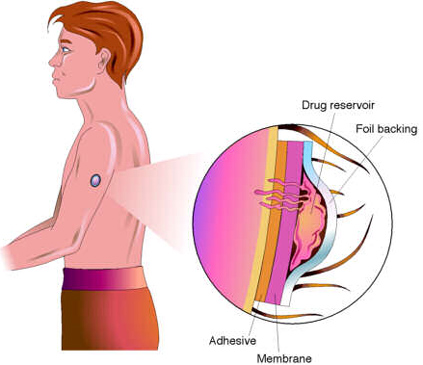
"ionto" refers to ions - positive and negatively charged particles
"phoresis" refers to one organism or compound assisting the transport of another organism or compound"
So - iontophoresis describes a process of passive and active transport of ions across the skin.
Iontophoresis adds energy, using direct current, to transport ionized medication across the skin and into underlying target tissue.
It's Coulomb's Law! Small amounts of current help overcome skin impedance, and medication is delivered based on:
Applying a charge to the skin changes the flow of ions through the skin, reducing it's resistance and enhancing the amount of and type of medication that can travel below the skin's surface to produce a therapeutic dosing effect.

A systematic review of iontophoresis in the treatment of lateral epicondylitis (tennis elbow) indicates low to moderate evidence in support: McKivigan, J. M., Yamashita, B., & Smith, D. (2017). A Systematic Review on the Efficacy of Iontophoresis as a Treatment for Lateral Epicondylitis. Research & Investigations in Sports Medicine, 1(3), Article-RISM.
Back when I was in PT school, phoresors were electrical devices called phoresors (see image below), powered with a 9V battery, with clip-on leads to be placed on the electrode. Current was administered using two electrodes.
One electrode was filled with the medication. This is the active electrode, and one carbon adhesive electrode as the dispersive electrode.
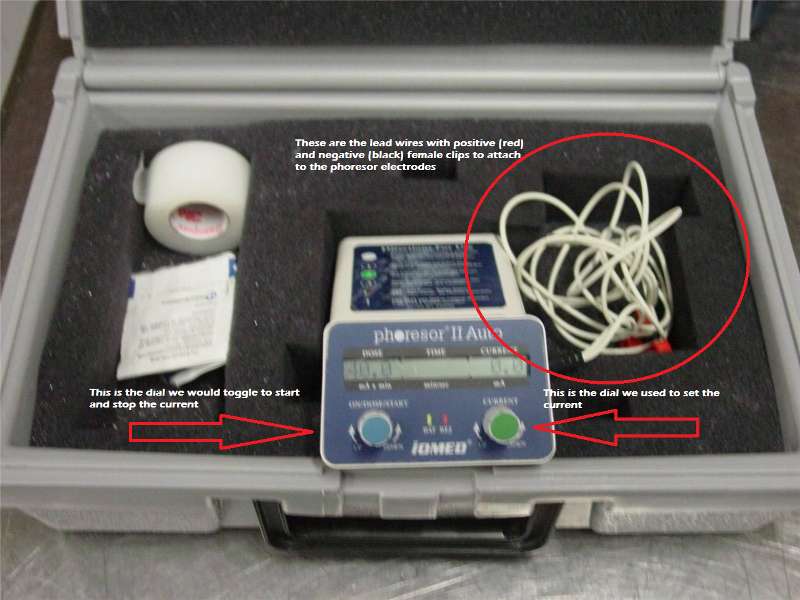
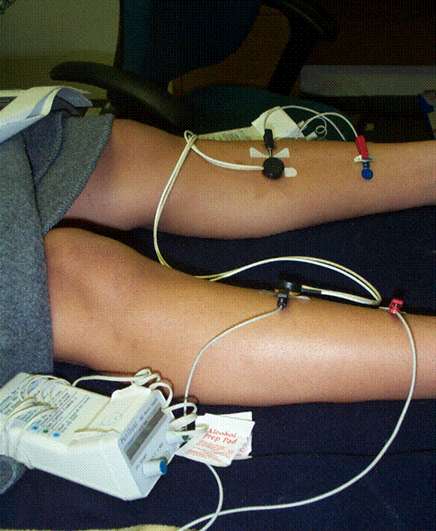
The clinician set the amount of direct current, in milliamperes (mA) applied by the phoresor to the active electrode. The phoresor would calculate the treatment time to achieve a 40mA - min dose.
For example, if the patient comfortably receive 4mA of direct current, then the treatment would last 10 min (4mA x 10 min = 40mA - min). The challenge is that patients have varying sensitivities to current and varying nutritional and skin status, so when current is reduced for patient comfort, treatment times are longer (40mA - min dose at 2.0mA is now a 20 min treatment).
Most transdermal medication delivery by iontophoresis is simplified so that the source of current comes from the patch. These are called "wear-home" patches and the electrocircuitry is self-contained and can deliver medication over as long as a 24 hour period
A patch containing a positive and negative electrode adheres directly to the skin. One end of the electrode is filled with the selected medication, and the other is filled with standard saline (NaCl).
Patches contain a buffering agent that minimize the chances of a burn
Electrode configurations and shapes vary. This allows for good skin contact around surfaces. Patches are also designed to deliver different medication doses (e.g., there are 40mA-min, 60mA-min, and 80mA-min electrodes).
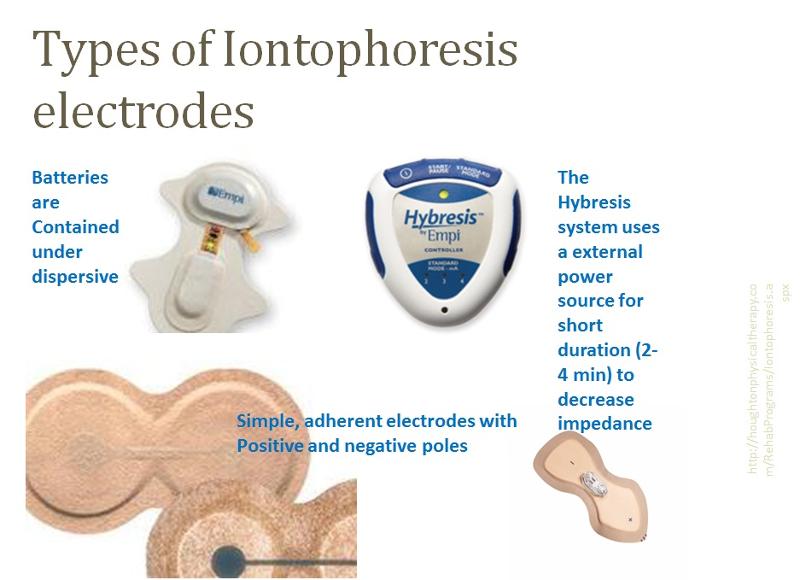
Key points - know the polarity of the drug or ion used and make sure there is good electrode contact with the skin to prevent skin injury
Drug selection is based on the intended effect in the tissue: anti-inflammatories, analgesics (pain medication), muscle relaxants, and sclerolytics (scar reducing) are all examples of common drug descriptions that may be delivered by iontophoresis
Medication dosages are based on drug properties. Typical dosages range from 40mA-min to 80 mA-min
Current density is the ratio of current (mA) to electrode surface area (cm2). Most electrodes are manufactured to be consistent with 0.5 mA/cm2 current density at the the cathode (negative pole)
Treatment time will depend on the electrode properties and method of introducing current (e.g., commercial unit vs. self-contained patch, vs. Hybresis)
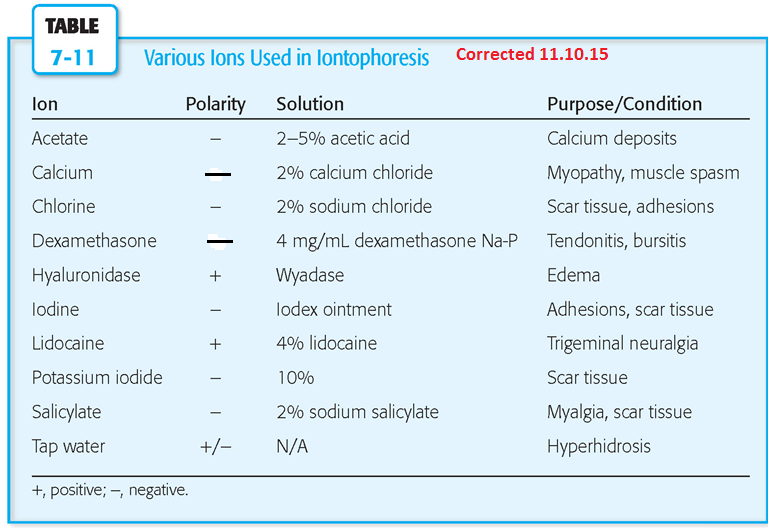
•Identify treatment area
•Usually by palpation, depth of treatment is shallow
•Check skin for abrasions
•Clean with alcohol
•Fill appropriate electrode with medication (e.g., dexamethasone is (-), so would be filled on electrode identified as (-)
•Fill opposite electrode with normal saline
•Apply to skin, securing electrode by taking care to press only the edges of patch
•Depending on delivery method, introduce low current and calculate treatment time as needed based on targeted dose
"phono" refers to sound
"phoresis" refers to one organism or compound assisting the transport of another organism or compound"
So - phonophoresis describes a process where the heating effect from ultrasonic waves increases the permeability of skin and deliver topical medication to the underlying tissue.
Research does not support the claim that 3 MHz is a sufficient frequency to increase cellular permeability; Many studies of phonophoresis are based on in vitro (lab tests, cellular level, or non-live tissue)
The amount of medication that can be pushed under the skin is also dependent on the properties of the medication itself; medications used have different levels of "phonophoretic enhancement" based on their chemical and molecular structure
Hydrocortisone and analgesics (like salicylates and lidocaine) are the most commonly used topical agents with phonophoresis. Research shows mixed findings in the amount of anti-inflammatory drug delivered using phonophoresis compared to controls. Currently, there is very low evidence of its benefits or efficacy.
|
|
Iontophoresis |
Phonophoresis |
|
Mechanism |
Uses ionic forces / direct current to deliver charged medication through skin through active transport
|
Uses thermal effect from ultrasonic waves to increase permeability and allow for passive transport of charged and uncharged (neutral) medication through skin
|
|
Medication |
Medications are ordered by the physician and mixed in solution by a pharmacist |
Medications are ordered by the physician and mixed by a pharmacist into the ultrasound coupling gel
|
|
Method |
Direct current applied through an absorbent electrode; current may be applied through an external device, or embedded in a "wear home" patch
|
Acoustic energy (ultrasound) through a medicated coupling agent (gel); used in thermal applications
|
|
Safety |
Screen for skin (integrity, sensitivities) Check charge of medication before applying to electrode Limit current to 4-5mA if using a iontophoretic device |
Screen for contraindications for ultrasound treatment "Whipping' coupling agent prior to application adds air and decreases acoustic transmission
|
|
Dosage |
Calculated as current over time (milliampere - min; mA - min) |
W/cm2 over time (min) Actual dose of medication varies with medication properties |
Link to APTA Reference Document for Iontophoresis
Link to Outline of Iontophoresis Summary